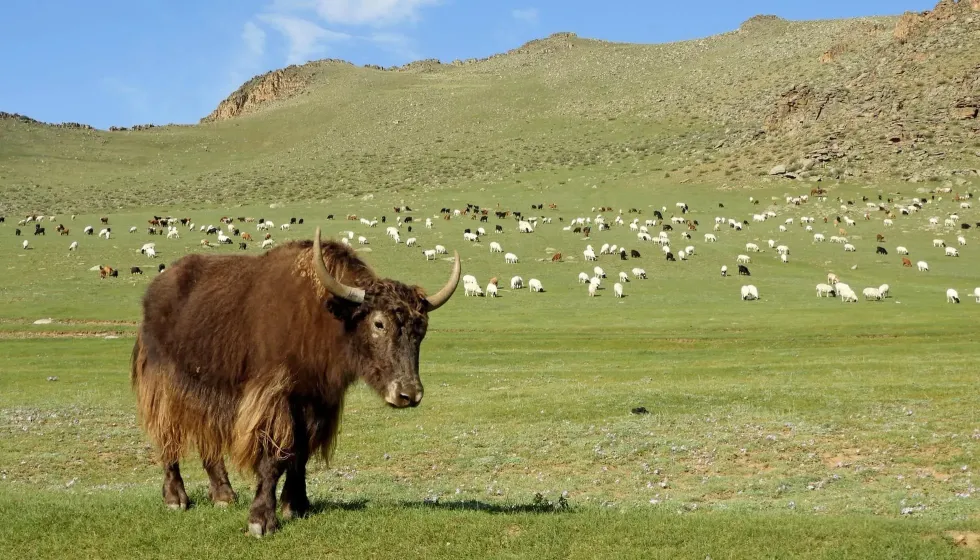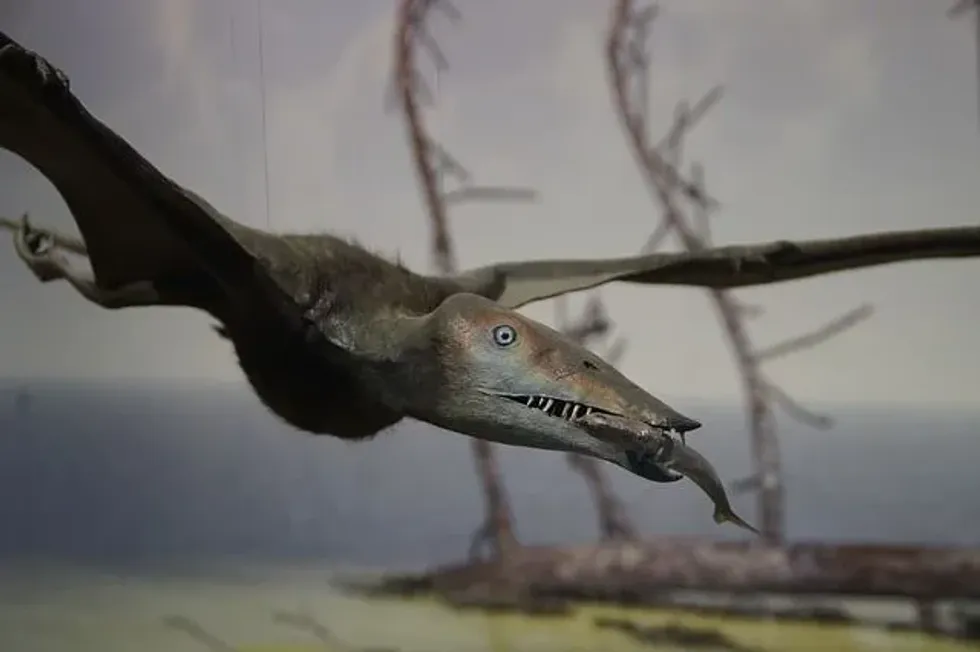The wild yak is a type of cattle animal found in the Tibetan Plateau of Asia. Considered to be a descendant of the Bos primigenius about a million years ago, the wild yak is found in Tibet, Nepal, China, and India.
Apart from the Tibetan plateau, the wild yak was once found in southern Siberia around Lake Baikal but has been extinct in Russia since the 17th century. The wild yak shares many similarities with domesticated yaks (Bos grunniens).
Domesticated yaks are relatively smaller than wild yaks in size, and their number is greater than wild yaks as well.
Wild yaks are mostly blackish-brown in color, but a unique type of golden-colored wild yak is found in China. However, the golden wild yak is considered to be endangered in China due to its incredibly low population.
Keep reading for more fascinating facts about the wild yak! If you liked this article with interesting wild yak facts, also check out our other articles with amazing facts about yak and cheetahs.
Wild Yak Interesting Facts
What type of animal is a wild yak?
A wild yak (Bos mutus) is a type of cattle animal.
What class of animal does a wild yak belong to?
The wild yak belongs to the Mammalia class of animals.
How many wild yaks are there in the world?
According to the references made in a population study carried out in 2008, there are around 10,000 mature individuals or wild yaks in the world.
Where does a wild yak live?
The wild yak is predominantly found in the northern region of Tibet and some parts of the north of China, including Qinghai and Xinjiang. They are also found in the Ladakh area of India. Million years ago, the wild yak population was also found in Bhutan but they are now extinct in this country.
What is a wild yak's habitat?
The main habitat of wild yaks is the alpine tundra found in the mountains of Tibet. They are found in the barren habitat of treeless uplands found in mountains and plateaus. They can survive in extremely cold temperatures and can walk through snow during the intense winter season.
Who does a wild yak live with?
In the past, it was seen that wild yaks spend their life in large herds of around 100 to 200 individuals. Recent studies show that males roam in solitary herds of around two to five individuals while females and their young move together in groups comprising six to 20 in number, but this can expand up to 100.
How long does a wild yak live?
A wild yak lives for around 25 years in the wild.
How do they reproduce?
Throughout the year, male and female wild yaks spend time in separate herds as females and young yaks. Males will spend time in smaller groups or alone.
The mating season of wild yaks is around September with calves being born in June. During the mating period in September, males join the larger herds with females and compete within themselves.
Females give birth to a single calf every other year, and the calf reaches physical and sexual maturity when it becomes six to eight years of age. The gestation period for female yaks is around nine months before they give birth.
What is their conservation status?
The wild yak is listed under the Vulnerable category of the Red List maintained by the International Union for Conservation of Nature (IUCN). It was previously considered Endangered, but the category was changed in 1996 based on the rate of its population decline.
Wild Yak Fun Facts
What does a wild yak look like?
Domestic yaks (Bos grunniens) and wild yaks (Bos mutus) have a blackish-brown pelage with large black upward curved horns. They have long, shaggy hair with a dense, woolly undercoat that covers their entire body and protects them against the cold.
Domestic yaks (Bos grunniens) and wild yaks (Bos mutus) are powerful, heavily built animals with large frames, strong legs, and rounded hooves.
Their body is covered with a lot of hair to protect them against the cold. Their coat is black or dark brown, and their tails are long like a horse.
How cute are they?
A wild yak (Bos mutus) is not very cute in the conventional sense. They are quite large, unkempt, and are not known for their friendly characteristics as they mostly run away from humans.
How do they communicate?
Wild yaks mostly communicate with each other through sound, physical touch, or body language. When faced with a threat, wild yaks snort loudly to alert each other. When facing danger, wild yaks mostly run away from the perceived threat. Communication between the genders heightens during the breeding season in September.
How big is a wild yak?
The wild yak is one of the largest animals among the bovid species found on Earth. Their length is usually between the range of 7.9-12 ft (2.4-3.8 m).
Their tail is 24-39 in (60-100 cm) in length, and they are approximately 5.2-6.7 ft (1.6-2 m) in height. A wild yak is around five times the size of a badger as badgers grow up to 1 ft (30.4 cm) in height.
How fast can a wild yak run?
Wild yaks might be large animals, but they can run quite fast in contrast to their huge size. They can also swim comfortably in a river and can also trudge through the snow and help clear a path for people. When they step into a marsh, wild yaks do not panic but plod through in a swimming-like motion.
How much does a wild yak weigh?
Wild yak females weigh about one-third the total weight of male wild yaks. The average weight of adult males is around 660 lb (1000 kg), while female yaks weigh around 2202 lb (300 kg).
What are the male and female names of the species?
There are no separate, unique names to refer to males and females of the wild yak (Bos mutus) species. Therefore, they are usually referred to as wild yak males or wild yak females.
However, in the Tibetan language, the word 'yak' is used to denote the males of the species, and the females of the species are called 'dri' or 'nak'.
What would you call a baby wild yak?
A baby wild yak is referred to as a calf.
What do they eat?
Although they are of separate species, like other cows, the yak also has more than one stomach. They use their multiple stomachs to derive all the nutrients from the plants.
The wild yak is a herbivore known for its grazing. They mostly eat grass, shrubs, and small plants as a part of their diet. Their diet also includes moss and lichen.
Are they dangerous?
Wild and domestic yaks are not predators but are preyed upon by Tibetan wolves found in the Tibetan plateau. Wild yaks get quite aggressive when they defend the young in the pack, but they generally stay away from humans and may even run away if approached.
However, sometimes wild yaks can become quite aggressive towards their cousin yaks and attack and kill domestic yaks.
In addition to that, wild yaks are also quite dangerous as they carry many zoonotic diseases. Zoonotic diseases are diseases that can jump from animals to humans through proximity and touch. These yaks carry a range of bacterial and viral diseases, including anthrax, tetanus, tuberculosis, and botulism.
Would they make a good pet?
Wild yaks would not make a good pet at all. These animals are not domesticated like the domestic yak (Bos grunniens) and prefer to roam around in the wild. They also do not like to be near humans.
Did you know...
The wild yak was considered to be extinct in Nepal years ago since the '70s, but they were rediscovered in 2014 in the Humla region. This pleasant discovery led to the wild yak species being printed on Nepal's currency!
Yak milk is considered to be a superfood in some regions of China. The milk derived from yaks is considered to be extremely nutritious and it can also be used to make butter.
Wild yaks can swim! They can swim in frozen water without it affecting their body temperature thanks to their thick, wooly fur coat.
Why are wild yaks endangered?
The wild yak is listed as Vulnerable by the International Union for Conservation of Nature (IUCN) due to the low population of the animal. One of the main reasons why the wild yak is endangered is poaching or hunting by humans.
Authorities in Tibet and China are taking steps to ensure that hunting stops. Interbreeding with domesticated yaks has also led to a decrease in their population.
What is the difference between a cow and a yak?
A yak (Bos grunniens) is a species related to cattle (Bos taurus). A yak and cow are separate species, although there are some similarities between both.
Cattle are far more domesticated than wild yaks and are bred for their milk and butter.
A cow is much smaller than a domestic yak (Bos Grunniens) and lacks many of the characteristics of yaks, such as outer hair and a woolly undercoat. The number of cows is also considerably higher than that of a wild yak, and they live to a younger age as well.
Here at Kidadl, we have carefully created lots of interesting family-friendly animal facts for everyone to discover! Learn more about some other mammals including the Greenland dog, or pilot whale.
You can even occupy yourself at home by drawing one on our wild yak coloring pages.










